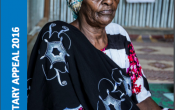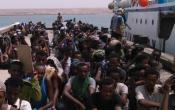Somalia
Operation: Somalia
Location
{"longitude":45,"latitude":6,"zoom_level":0}
Latest update of camps and office locations 21 Nov 2016. By clicking on the icons on the map, additional information is displayed.
Key Figures
| 2017 planning figures | |
| 80% | of primary school-aged refugee and asylum-seeking children will be enrolled in primary education |
| 40% | of Somali returnee households will be living in adequate dwellings |
| 35% | of refugee and asylum-seeking people of concern (18-19) targeted with own business/self-employed |
| 32% | of returning people of concern (18-19) targeted with own business/self-employed |
| 2015 end-year results | |
| 1,841 | refugee and asylum-seekers had access to primary health-care services |
| 168 | SGBV survivors were identified and assisted with medical and material aid, as well as psychosocial and legal counselling |
| 657 | asylum-seekers and refugees received free legal counselling |
| 1,413 | individuals benefitted from a subsistence allowance |
| 660 | IDP households were supported with business start-up cash grants |
| 125 | IDP households received equipment and materials for livelihoods support |
| 2,500 | individuals were assisted to return to South Central Somalia, Somaliland and Puntland |
Latest Updates and Related Links
29 March - 11 April 2016
People of Concern
2%
Increase in
2015
2015
| 2015 | 1,188,631 |
| 2014 | 1,160,286 |
| 2013 | 1,286,176 |

[["Refugees",8081],["Asylum-seekers",10120],["IDPs",1133000],["Returned IDPs",5000],["Returned refugees",32344],["Others of concern",86]]
Loading ...
Budgets and Expenditure for Somalia
< Back
2015
{"categories":[2012,2013,2014,2015,2016,2017],"budget":[48.71903122,55.30925953,69.833919642,99.153880316,165.91668118,85.302905632],"expenditure":[24.72943047,23.14684963,26.5332932,36.1882683,null,null]}
{"categories":[2012,2013,2014,2015,2016,2017],"p1":[9.59466285,9.03116226,24.124382822,44.514196076,93.4138341,29.226757644],"p2":[null,null,null,null,null,null],"p3":[null,null,11.40125058,13.09633044,34.86243341,20.176075504],"p4":[39.12436837,46.27809727,34.30828624,41.5433538,37.64041367,35.900072484]}
{"categories":[2012,2013,2014,2015,2016,2017],"p1":[4.63287788,5.57949325,7.83034228,19.02820407,null,null],"p2":[null,null,null,null,null,null],"p3":[null,null,3.1304473,6.92298829,null,null],"p4":[20.09655259,17.56735638,15.57250362,10.23707594,null,null]}
Loading ...
CHOOSE A YEAR
- 2014
- 2015
- 2016
- 2017
Working environment
The protection and operational environment in Somalia is anticipated to remain complex in 2017 due to continuing insecurity in many parts of the country. The political and social structure remains challenging while public infrastructure and services remain underdeveloped, and the growth of economic activities is low. More generally, conflict and violence is expected to continue in some parts of Somalia due to the presence by non-State armed actors in southern and central regions, and other factors. This is expected to result in further internal displacement as well as in further restrictions of humanitarian access and higher risk exposure for UNHCR’s people of concern.Nonetheless, while socio-political conditions in the country remain unpredictable, UNHCR will continue ensuring provision of protection and assistance to refugees, asylum seekers and IDPs as well as the voluntariness of returns from the host countries, including enhance (re)integration projects benefiting all UNHCR’s people of concern including host communities.
The Somali authorities at various levels have agreed to include specific interventions to support refugee returnees and internally displaced people in the three year national development plan (NDP) which is expected to be in place by January 2017. This will provide a platform for UNHCR to strengthen its engagement with development actors, in order to ensure conditions for sustainable return and (re)integration. UNHCR will also develop a framework for partnerships and coordination to identify and facilitate durable solutions for people of concern, together with relevant ministries.
The Government of Somalia continues to extend hospitality to all refugees and asylum-seekers. It also offers security escorts for convoys containing Somali refugees returning from Kenya, and provides land for returnees in some areas.
Key priorities
In 2017, UNHCR will continue to focus on life-saving, protection and assistance activities, as well as durable solutions initiatives for people of concern, including:• strengthen the protection environment through capacity building for Government structures (federal and regional);
• strengthen RSD and registration capacity, including through verification exercises;
• provide protection, assistance and basic services for urban refugees, in line with the out-of-camp policy;
• pursue durable solutions through resettlement and local integration initiatives;
• support and monitor voluntary returns of Somali refugees from Kenya, in line with the “Tripartite agreement governing the voluntary repatriation of Somali refugees living in Kenya” and the guidance provided by the “Tripartite commission for the voluntary repatriation of Somali refugees living in Kenya”;
• enhance reintegration activities and promote self-reliance and income-generating activities;
• provide basic services and infrastructure in areas of return benefitting refugee returnees, IDPs and host communities;
• support peaceful coexistence through community-based projects;
• promote durable solutions for IDPs through local integration, facilitate voluntary return to areas of origin and support reintegration through awareness-raising;
• advocate for permanent land tenure for IDPs and returning IDPs.
UNHCR will also maintain emergency response capacity as needed.
Lack of timely or inadequate funding would affect all people of concern to UNHCR in Somalia (refugees, asylum-seekers, IDPs and returnees), including with respect to access to protection, basic services, education and livelihoods. The planned sustainable return of refugees would also be jeopardized by inadequate or delayed funding, and urgent support is required in particular to strengthen basic infrastructure in return areas. Funding shortfalls for UNHCR’s operations would affect NGOs and other agencies that rely on the coordination and information provided by UNHCR in terms of shelter, education, prevention and response to SGBV as well as, protection and return monitoring.





